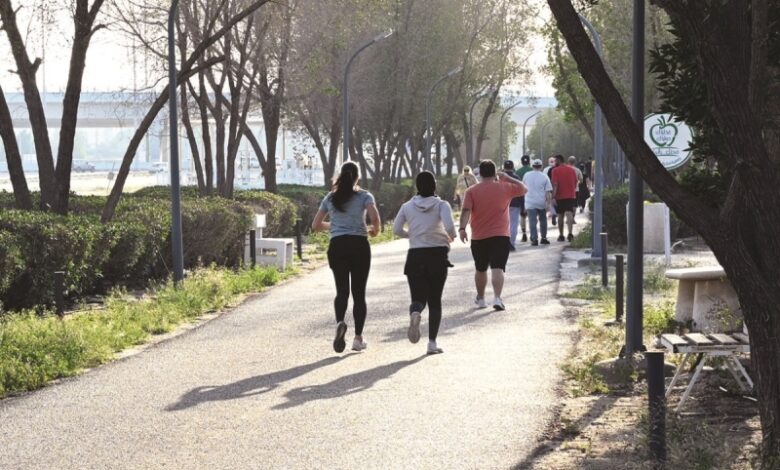When and how to exercise safely during Ramadan
Dr. Iman Mirza, physical therapy specialist, said the best time to exercise during the holy month is one to two hours before breaking the fast, with moderate activities such as walking, swimming, jogging, or cycling.

• Dr. Iman Mirza, physical therapy specialist, cautioned against exercising during the early hours of fasting, as this may lead to dehydration due to fluid and mineral loss, lower energy and blood sugar levels, and, in some cases, fainting or other health risks.
• Dr. Muhammad Bou Abbas said slow walking does not significantly increase heart rate, breathing rate, or blood circulation—key factors in aerobic exercise that contribute to improved health and physical fitness.
Many people are eager to engage in various sports during Ramadan, as it’s a popular strategy for maintaining weight and overall health. When it comes to timing and types of exercise during this holy month, preferences differ. Some individuals choose to work out while fasting, while others prefer to exercise after breaking their fast. Activities range from walking to weightlifting.
Before breakfast
For her part, Dr. Iman Mirza, physical therapy specialist, told Al Rai newspaper that the best time to exercise during Ramadan is one to two hours before iftar, with moderate activities such as walking, swimming, jogging, or cycling.
She added that exercising while fasting increases fat breakdown and oxidation, leading to greater fat consumption as an energy source and, consequently, weight loss—provided a balanced and healthy diet is maintained.
She cautioned against exercising during the early hours of fasting, as this may lead to dehydration due to fluid and mineral loss, lower energy and blood sugar levels, and, in some cases, fainting or other health risks.
Dr. Mirza also warned that elderly individuals or those with conditions such as diabetes, high blood pressure, or heart-related issues should avoid exercising while fasting and instead work out after iftar.
Lifting weights after breaking the fast significantly enhances muscle strength
Regarding young individuals engaged in weightlifting, Dr. Mirza noted that experts remain divided on the ideal time for strength training during Ramadan. However, numerous scientific studies indicate that lifting weights after breaking the fast significantly enhances muscle strength and helps maintain muscle mass compared to training while fasting.
She added that some research suggests weightlifting during fasting hours is possible if an individual’s health permits, though it may not contribute to increased muscle strength or improved workout performance.
Drink adequate amounts of water and fluids
Mirza emphasized that to minimize the risk of injuries or health issues while exercising during Ramadan, it is essential to drink adequate amounts of water and fluids to prevent dehydration, which can increase the likelihood of muscle cramps or tears. She also advised against engaging in high-intensity sports or exercising for extended periods while fasting, as this may lead to serious health risks.
She added that it is important to avoid sudden or drastic changes in exercise intensity or type, as this could increase the risk of injury.
In conclusion, she said that “People who exercise should ensure they get enough sleep, as it is essential for recovery and muscle tissue development. They should also follow a balanced and moderate diet to prevent weight gain.”
Walking is one of the most popular forms of exercise
For his part, Dr. Muhammad Bou Abbas said that “Walking is one of the most popular forms of exercise for people of all ages due to its simplicity. It can be practiced by individuals with varying levels of health and physical fitness.”
He added that “Walking is an aerobic activity that enhances cardiovascular health and helps protect against various diseases, including high blood pressure, type 2 diabetes, and certain types of cancer.”
Bou Abbas explained that the reasons for walking vary from person to person. Some walk to lose or maintain weight, while others do so for enjoyment, mood enhancement, or overall health.
He added that “However, walking may not always provide the desired health benefits if not done correctly. Some individuals walk at a slow or comfortable pace for long distances, believing they are engaging in effective exercise.”
Bou Abbas noted that slow walking does not significantly increase heart rate, breathing rate, or blood circulation—key factors in aerobic exercise that contribute to improved health and physical fitness.
Importance of monitoring heart rate
Bou Abbas emphasized the importance of monitoring heart rate, which can be done using smartwatches or smartphone applications. He explained that for walking to be beneficial, the heart rate must rise during brisk walking.
He added that another way to assess whether the walking speed is appropriate is sweating. Brisk walking raises the body’s internal temperature, leading to perspiration. Therefore, if a person does not experience an increased heart rate, fatigue, or sweating while walking, this may indicate that their pace is too slow to be effective.
Wearing sports shoes
Bou Abbas also highlighted the importance of wearing sports shoes suited to the shape of one’s feet and performing warm-up exercises for a few minutes, including stretching and joint flexibility exercises. Additionally, he advised gradually increasing walking speed and distance while incorporating rest days to allow the body and muscles to recover, reducing the risk of injuries.














